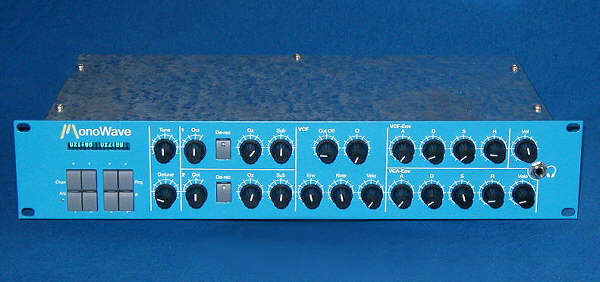|

| |
Modulus MonoWave

MonoWave #0010 - one of 25 in the whole world :-)
This little fellow is the complete antithesis to today's synthesizer market:
 | monophonic with 2 DCOs and 2 suboscillators |
 | no program memory |
 | completely analogue sound processing - and that today, where everybody is
moving to digital simulations... |
... but it sounds extremely good!
After this list of strange attributes (at least for the younger readers, hee
hee), here are the facts about what it can do:
 | 2U 19" rack device with MIDI In/Thru, Audio Out and a built-in
universal PSU (no ugly wall wart needed!)
Mine's got a custom feature - a Line In input that allows to route an
external signal through the VCF and VCA sections. |
 | 2 digitally controlled oscillators with a selection of 256 waveforms, 127
from the PPG Wave, and a suboscillator
 | Extremely fine detuning regulation between the two oscillators; in the
latest software version, it can be used in two modes: fine detune (-1..+1
semitone) or semitone detune (-8..+7 semitones). |
 | "De-Rez" switch to reduce the resolution of each of the
oscillators. This allows to produce the now well-known aliasing effects that
made the analogue-trained listeners cringe 20 years ago :-) |
 | Moog-Filter
Cloned with permission of the master himself, with the original sound and a
lot of regulation possibilities. Of course you can turn it up into
self-oscillation.
 | ADSR Envelopes, separately tweakable for VCF and VCA. VERY fast beasts.
 | Waveforms can be controlled via MIDI CC for each of the oscillators
separately
 | Arpeggiator with some modes, normal and staccato style |
 | LFO, can be separately added to oscillator 1, 2, and VCF |
 | nearly consequent WYSIWYG principle - there's a separate controller for
nearly all sound forming elements. Some global elements (MIDI channel,
arpeggiator mode and the like, which are stored in non-volatile memory) can
be reached in submenus. |
| | | |
For people who like to tweak and love to see at one glance how the sound
works, rather than working through myriads of submenus, and who can live without
the possibility to access many sounds in fractions of a second, I can only
recommend this little gem. It's big fun!
More information, demos, how to buy and the like can be found on the Modulus
web site.
 |
Last update: 10/26/03 |
|
|